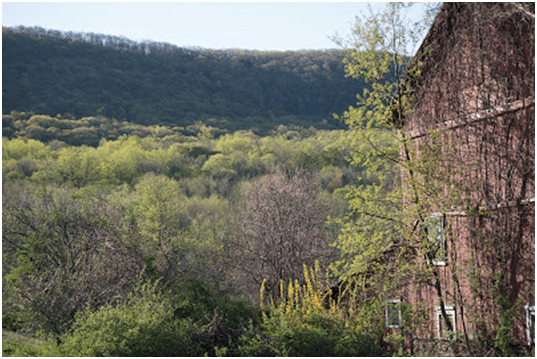This is my part of the natural world, and I can feast on all the natural beauty around me for years to come.
But there have been many more decisions I have made to assure success as an outdoor photographer — including the decision to use Singh-Ray filters. I’d like to talk a bit about the one filter that, as a landscape photographer, is almost always on my lens. That filter is the Singh-Ray LB Neutral Polarizer.
 Many photographers only think of using their polarizing filters when they want to create a deeper blue sky behind the white clouds in their images. For me, however, the biggest reason to use a polarizing filter is to eliminate unwanted reflections and glare off the bodies of water — of any size — as well as the surfaces of leaves, branches, wet rocks, and other reflective objects in each scene. By carefully adjusting my polarizing filter, I can block the glare being reflected into my lens and allow the natural colors to come forth more prominently in the image.
Many photographers only think of using their polarizing filters when they want to create a deeper blue sky behind the white clouds in their images. For me, however, the biggest reason to use a polarizing filter is to eliminate unwanted reflections and glare off the bodies of water — of any size — as well as the surfaces of leaves, branches, wet rocks, and other reflective objects in each scene. By carefully adjusting my polarizing filter, I can block the glare being reflected into my lens and allow the natural colors to come forth more prominently in the image.
The image at right (top) shows a scene with no filter used. The image below that is the exact same scene photographed using a Singh-Ray LB Neutral Polarizing Filter. Notice that the sky is virtually identical in both photos (proving how neutral this filter really is). But the barn, tree leaves, flowers, and tree branches all are much more attractive and appear more vibrant with the use of the polarizer. Any time there is foliage in my viewfinder, my Singh-Ray LB Neutral Polarizing Filter goes on the lens.
The above image, made in the Bashakill Wildlife Management Area, Wurtsboro, NY, was made with overcast skies above and a low sun throwing warm light into the scene from the horizon. Without the Singh-Ray LB Neutral Polarizing Filter, the colorful leaves and reflective tree trunks would have lost much their radiant colors by reflecting the scattered light that was present. An important additional benefit of the LB Polarizer is the low filter factor — which gives me 2/3-stop more light transmission than what I would get with many traditional 2-stop polarizerss. This image was made using a moderate telephoto lens and there was a slight breeze blowing. The lower filter factor allowed me to use a faster shutter speed (without raising the ISO which would have added noise and reduced dynamic range) which kept leaf blurring to a minimum.
In Ricketts Glen State Park, PA, this lovely falls features moving water, and rain-soaked leaves and wet rock slabs – all highly reflective surfaces. The LB Neutral Polarizer enabled me to control the exact amount of reflection from these surfaces. And again, in this very dark scene, the ‘lighter, brighter’ filter factor of the LB Polarizer allowed me to keep my shutter speed exactly where I wanted it to minimizing the movement of the windblown branches.
Here’s a more abstract image with subtle coloration of the spring blossoms and leaves. It was taken on a bright overcast day. The gray sky above caused the subtle colors to change to shades of uninteresting gray. The Singh-Ray LB Neutral Polarizer allowed me to block the gray reflections from the foliage, tree trunks, and branches, and allow their beautiful but subtle colors to be revealed.
These next two images were made in Sam’s Point Preserve, Cragsmoor, NY, and were taken at different times of the year; early summer (above) and full-on autumn (below). In addition to the Singh-Ray LB Neutral Polarizing Filter, I also used a 3-stop Reverse ND Grad since the sun was directly on the horizon line and the sky was at its brightest on the horizon.
The Reverse ND Grad was the perfect choice to manage the extra high dynamic range of these two scenes. And it is simply remarkable how I was able to stack two filters, shoot directly at the sun, and still maintain contrast and detail in the overall scene and backlit leaves.
This final image, of the Hudson River, was made in winter. By using an LB Neutral Polarizer i was able to maintain maximum detail in the ice patterns in the river. Light was scattering everywhere from the rising sun and breaks in the storm clouds. The polarizer blocked the scattered light and allowed the rich detail to be fully visible.
If I am out shooting landscapes, you can be sure that I have my Singh-Ray LB Neutral Polarizing Filter. Almost every outdoor scene can benefit from this filter. My second most used filter is my Reverse ND Grad filter. I love to shoot directly at the sun, and this filter allows me to capture those scenes beautifully without resorting to HDR techniques (which can often alter the natural tonal gradations otherwise present in the image).
Greg leads photography workshops and tours for organizations such as the Center for Photography at Woodstock, the Adirondack Photography Institute, and the New Britain Museum of American Art. His first photo book, The Hudson River, A Great Amercian Treasure (Rizzoli, 2008) was included in The Bloomsbury Review’s Favorite Books of 2008.







